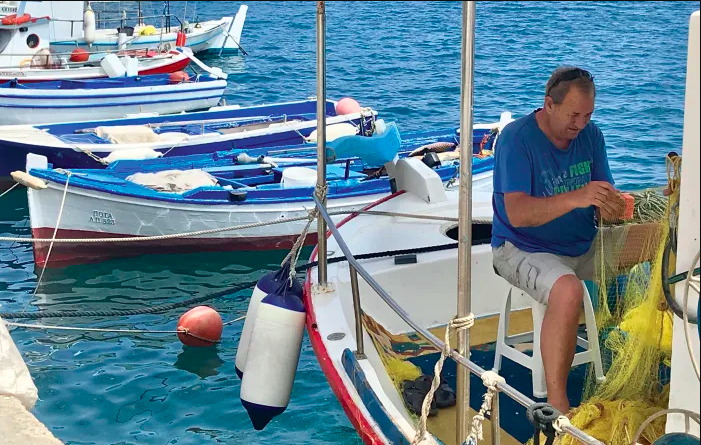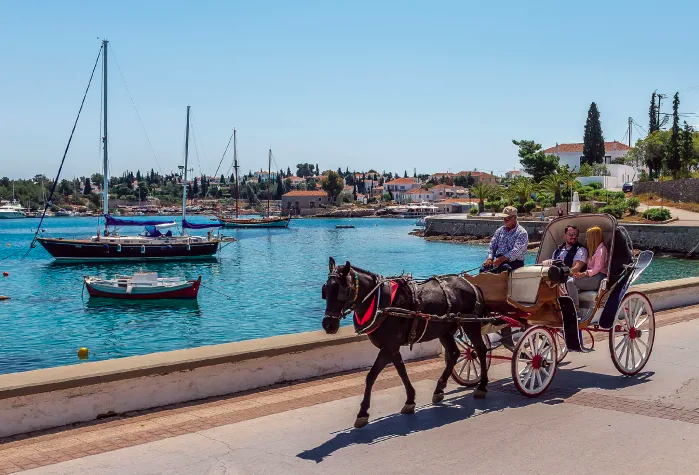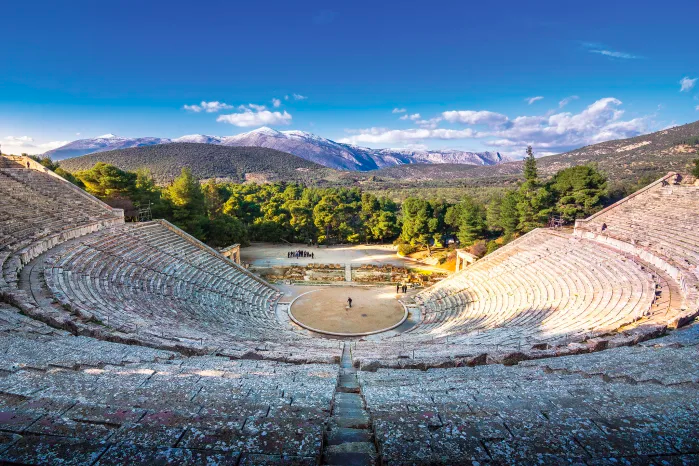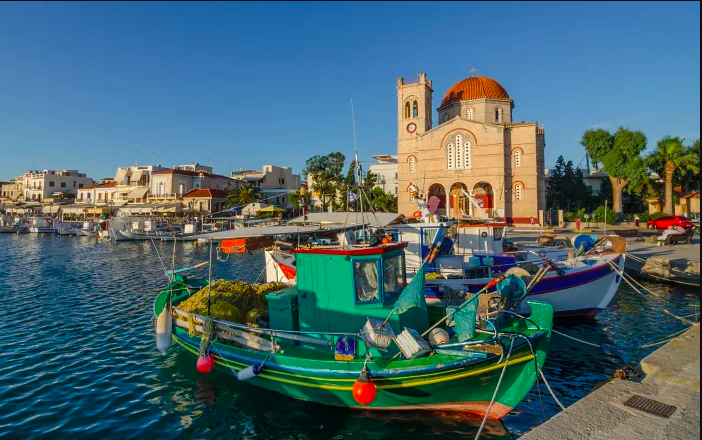Yacht Charter in the Greek Isles with Navigare Yachting
This past year a group of friends and I chartered from Navigare Yachting, based in Agios Kosmas Marina, away down from the port of Piraeus outside of Athens. Our Sun Odyssey 519 was ready and waiting at the dock, completely spotless. I also had three of the base personnel at my complete disposal within minutes of arrival. It was such an enthusiastic welcome, I double-checked the name of the boat on my paperwork just to make sure all this fanfare was for me. Yup, the 2018 vessel, Misty, was mine for the week.
After that, we loaded up with some barebones provisions, which in Greece consist of olives, tomatoes, pounds of feta, and numerous bottles of local wine. There’s no need to overbuy at the start of a charter in this part of the world, since the provisioning opportunities, and tavernas, are many.
Although I was set to explore Greece for the third time and wanted to show my guests the most special islands, I also wanted some new adventures of my own. I was, therefore, determined to explore where I hadn’t explored before and press reset on all those places I had. Because we had only six days, the magnificent, but far-flung Cyclades to the south were off-limits. That left a quick tour of the Saronic Gulf, which is closer and more compact. As I pored over the charts, I found Hydra mesmerizing. But its tiny harbor was a challenge for a big boat to moor in, so I decided to leave it for another day as well.
I always make it a point to listen to the base staff and their recommendations, because they positively light up when you ask about their favorites. In this case, the guys guided me toward a destination I thought might be too far away, but they assured me was worth the trip. Navplion (also spelled Nafplio and Nauplion) beckoned from the top of the Argolic Gulf, some 20 miles north of the island of Spetses, where I’d have to make a 90-degree turn and head northwest. Twenty miles on a sailboat isn’t a matter of an hour, but I thought, “Why not?”

A fisherman mends his nets - a typical island scene.
Photo courtesy by Zuzana Prochazka for Sail Magazine.
Beam Reach to Spetses
On our first day, we sailed southwest nearly 50 miles on a nice beam reach, winding through Kolpos Ideas, or the Hydra Gulf. By the end, we were running out of daylight, so we pulled into the minuscule harbor on Spetses Island. I read the guides twice, but the most I got was a warning about the inner harbor being only 4ft deep, which made me suck in my stomach as we crept in. The harbor turned out to be a mix of private yachts, commercial boats, and fishing craft, and as we were looking around I happened to notice black clouds on the horizon. The wind was also now picking up, so out we went again, making a U-turn back to the bay to drop anchor with the other cruisers who’d opted to skip the draft headaches. We made it just before the gale overtook us.

There are no cars on Spetses; a horse and buggy are the closest you'll get to a taxi.
Photo by Shutterstock for Sail Magazine.
Ashore, we heard the clippity-clop of hooves as horse-drawn carriages made their way from one end of town to the other. Dinghying to a stone quay, we followed directions to Liotrivi, a seafood restaurant recommended by the base. Spetses, it turns out, is a gastronomic hub, with dozens of specialty eateries bunched together in a tiny town. Liotrivi was spectacular, with an unmatched waterside setting and impeccable, old-school service. That said, every café and restaurant we passed on the way to and from our dinner was right out of a Hollywood set—with candlelit charm and mouthwatering aromas wafting on the evening breeze. No wonder the beautiful people of Athens hop on their yachts or ferry over to spend the weekend here.
The following morning we set out to explore the rest of town, but instead of taking a carriage walked along the quay where we saw fishermen mending their nets. Our goal was to visit the home of the local heroine, Laskarina Bouboulina, a commander in the War of Greek Independence of 1821. A larger-than-life figure, Bouboulina was born in a Constantinople prison, but rose to the rank of admiral and eventually died in a family duel. With a history like that, I just had to learn more. Alas, the 300-year-old mansion that is now a museum was closed for the day. So much for meeting my new muse.

The ancient amphitheater at Epidavros can seat 14,000 and is still used for performances.
Photo by Shutterstock for Sail Magazine
Tough Climb on Navplion
That afternoon we weighed anchor and set course for Navplion, to the north, where after a long but relaxing motor through a light, squirrely breeze, we Med-moored on the town quay with plenty of sunlight left for exploring. Navplion’s horizon is dominated by the imposing fortress of Palamidi, a behemoth built in only three years by the Venetians during their occupation of the Peloponnese Peninsula in the early 1700s. I see anything on a hill as a personal challenge, so up we went—some 1,000 stairs. The views were incredible, and the exercise didn’t hurt either after a day on the boat.
The following morning we rented a car and drove north to the archaeological sites of Mycenae and Tiryns. Dating back from the 15th to the 12th centuries BC the two cities were at the heart of Mycenaen society, linked to Homer’s Iliad and Odyssey. What has been preserved and/or rebuilt onsite is exceptional, and if you can get away from the busloads of tourists, you may just settle into a feeling of awe when contemplating the civilization that once ruled here.
It was now blazing hot, so we set our sights on Epidavros (also Epidaurus) some 40 miles to the east. The ascription here was a celebrated healing center, with the medicine of the time being combined with the area’s mineral spring baths and a good dose of influence from the gods. People came from miles around in hope of being cured of whatever ailed them. To find out the nature of their illness, they spent the night in the endometria or sleeping hall. In their dreams, the god Asclepius would then advise them on their course of treatment. Another focus of the asclepeion was on physical exercise in the local stadium and on relaxation, perhaps in the complex’s well-preserved stone amphitheater, which is world-renowned for its design and acoustics. It can seat 14,000 spectators and is still used for performances today. I’m sure the mix of good old-fashioned exercise and a reduction of stress worked wonders for guests at this ancient spa.
Returning to Navplion in time for dinner, we found that at night the town becomes quite lively as the heat of the day dissipates. Shops, galleries, and restaurants opened up, and performers and singers took to the streets as Palamidi hung in the night sky. The next morning we made another trek up to Palamidi—just for bragging rights—and then said goodbye to Navplion, catching a glimpse of the 289-foot Maltese Falcon with its unmistakable masts poking at the clouds in the distance as we made our way south. The guys were right. It was well worth the trip.
Med-mooring on Poros
By now it was time to think about the return trip, so I set a course for Poros, an island with a narrow channel that is so quintessentially Greek, that it looks almost made up. The word picturesque doesn’t begin to do it justice. Winding your way past Timios Stavros church and around the perimeter of the town on your way to the long public dock on the northwestern side, you’re so close to the street it’s like watching a Poros IMAX film reeling by as you sit on the deck.
We Med-moored at a wide-open dock, which may sound idyllic, but which I knew from experience is something you never want to do in Greece—as was soon reconfirmed. Touring the town, we climbed up to the clock tower for a view of the colorful buildings below. Since I always carry a bag of cat food with me in Greece, I soon had some furry friends.
That night, finding a place for dinner required little more than strolling the waterfront and picking out one from the dozens of lovely tavernas there. Not so pleasant, arriving back at the boat, there were now (as I feared there would be) anchor chains leading every which way and mostly right over ours. The next morning we were the first ones up as I wanted to get an early start and give my crew a full day on Aegina (also Egina) Island, 12 miles away. Disheveled heads popped up out of cabins at the sound of our windlass, and we ended up spending the better part of 45 minutes picking other people’s anchors off our chain, wrestling with the boathook, and fending off shouted advice from the many “experts” in the area. Only one of the experts jumped in his dink to help out.
Outboard Woes at Aegina
Aegina is one of my favorite islands, so I didn’t mind revisiting an old haunt. However, the circular harbor is chock full of fishing and ferry traffic so we opted to anchor out—a decision that came back to bite us later, as our outboard conked out on the run back, leaving us with a brisk row against wind and chop back to Misty.
Aegina town itself is a wonderful maze of touristy cafes and a genuine local lifestyle, complete with a fish market and dozens of pistachio stands. Once again, we rented a car, since a couple of Aegina’s true gems are inland and absolutely a must to visit.

There’s a timeless quality to fishing ports like Aegina town.
Photo by Shutterstock for Sail Magazine
There’s some debate whether the first of these gems, the Doric temple of Aphaia (also Aphaea) was initially dedicated to Athena or Aphaia, two goddesses of ancient Greece. As many as three different temples may have been built on this site as the centuries ticked by. Whatever the case, the last remaining structure here is phenomenally well preserved and an absolute wonder. There’s also a small but excellent two-room museum filled with original statuary taken from the temple. Anywhere else in the world, these treasures would be under armed guard. But here we just browsed through at our leisure, along with history.
From Ancient Greece, we rolled on to the 1800s and gem number two, a weirdly fast transition when you think about it. The Agios Nektarios church and monastery are dedicated to the Orthodox theologist and mystic, Agios Nektarios, a respected healer and miracle worker who established the Holy Trinity nunnery on the grounds and lived out his days there as a monk. Women must have their legs covered when entering either the monastery or the church, and since the site is popular with tourists, free “skirts” are provided at the door.
Returning to the charter base at sunset, we were the last boat to tuck in. After securing our dockline the base personnel used a quarter-mile-long hose to refuel the boat from a truck in the parking lot. I’ve never seen that before, but hey, it worked.
By now you may have noticed that there are multiple ways to spell every Greek town or island name. Just to make it more confusing, the old town on every island is called Hora or Chora, and street names are written in the Greek alphabet, so each evening, we congratulated ourselves on ending up where we started the day—at our boat.
As for our trip overall, we had taken in some new sites and some previously visited places, but also found many different restaurants to try, new photo angles to use, and offbeat things to do. Once again, we had ticked the “Greece” box. But as always, the best thing to do when it comes to any Greek vacation is the charter, sail, and repeat—often.
Source: Sail Magazine
Written by: Zuzana Prochazka

